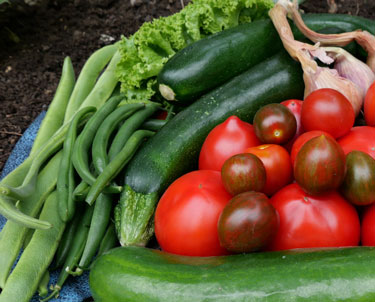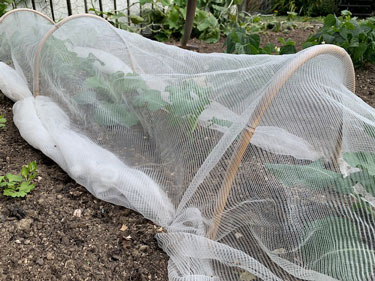Surviving summer
10 tips to help your garden survive and thrive in summer.
| 1 | Leave no soil uncovered. A blanket of mulch stops the baking sun stripping moisture from your soil. It insulates plant roots against temperature extremes and suppresses weeds that would otherwise compete with your plants for water. Pea straw makes an attractive mulch, perfect for vege gardens. Lawn clippings are a cost-effective alternative if spread thinly so not to form a hard impervious crust. Lawn clippings break down quickly so need to be reapplied more often. TIP: Trimmings from herbs and flowers, even pulled-out weeds (if they don’t have seeds), can be laid on the ground as mulch. |
| 2 | Boost soil biology. Humus gives topsoil its healthy dark colour. Loaded with essential soil microbes it acts like a sponge to hold water within the soil structure without waterlogging. Adding quality compost builds soil humus. A well-matured compost provides natural organic nutrients while improving the texture of both heavy and light soils. Seaweed supports microbiological life resulting in outstanding increases in plant health and plant yield. TIP: Vegetable seedlings and other potted plants suffer less from transplanting shock when soaked in seaweed solution at planting time. The natural hormones in seaweed assist germination and promote thicker cell walls rendering plants for resistant to attack from pests and disease. |
| 3 | Feed rapid growth and fruiting. Plants get thirstier and hungrier when they carry rapidly swelling fruit. Use fertiliser at planting time and throughout the growing season, to enhance flavours and yield on fruiting plants like cucurbits, tomatoes and strawberries. Ideal for vegetables growing in pots and as a quick boost for garden plants, use a balanced liquid fertiliser for all indoor and outdoor plants. Used regularly, liquid foods give your plants a boost and keep them healthy. |
| 4 | Water deeply. Rather than light watering every day, it is better to soak the soil every few days. This deep watering encourages roots to grow deeper into the soil so your plants will become more drought resistant. |
| 5 | Water low. Wet leaves are an invitation to disease pathogens. Wet the soil, not the plants. |
| 6 | Plan ahead. Check watering equipment and irrigation systems are up and running efficiently and swap watering responsibilities with friends and neighbours for holiday times. |
| 7 | Provide shelter. Some air movement is important for plant heath but wind will suck soil moisture via the leaves. A tall crops like corn can provide useful shelter for smaller and younger crops. Keep in mind, however, that vegetable plants also need sun. |
| 8 | Some like the shade. Lettuces and soft herbs such as basil, coriander and parsley do best in hot weather with some protection form the searing afternoon sun in mid summer. Morning sun is good. |
| 9 | Block flying pests. Bug net provides excellent protection from the likes of white butterfly caterpillars and psyllid. Choose a mesh fine enough to block the pests concerned. However, be aware that netting can also create humid conditions that can invite other problems, and will also block pollinators. Keep watch, get to know you pests and time it well. |
| 10 | Nurture nature. Plant a diverse range of flowers, vegetables and herbs to attract a diverse range of insects. Take care to minimise harm to beneficial insects if spraying for pests and disease control. Read the instructions, spray at the correct time and only those plants that are infested. |
15-Nov-2022


Straw mulch

Water deeply, water low.

Use bug netting to protect plants from caterpillars, vege bugs and pysllid.


